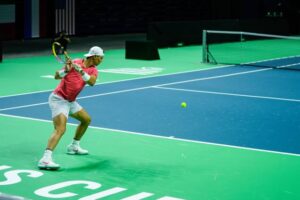The logistics at Wimbledon have now forced the question: Which is more powerful–the living surface or the living legends? Slippage on the Wimbledon grass prematurely determined the outcomes in both the first round matches of Serena Williams and Roger Federer. Novak Djokovic also slipped quite a bit in his first round victory. Tennis Twitter is asking if grass is an obsolete surface, just too tricky to use in 2021. Is it time for Wimbledon to ditch grass, as other Grand Slams have?
The answer is no. So obviously no. Wimbledon is unique and wonderful. It reminds us of a few good traditions, which can be comforting and just plain cool. That said, every action creates an equal and opposite reaction. Putting the roof on Centre Court was a bridge too far for Mother Nature. When you try to outsmart her, she’s going to fight back.
Closing the roof too quickly on a rainy, humid day early in the tournament–despite Herculean efforts to condition the air while doing it–traps the moisture inside the building and creates a surface which might be better played in golf spikes.
What to do, what to do? Here’s a list of “don’ts” to save grass-court tennis at Wimbledon while protecting the players:
Don’t Short-Change the Grass Season
The pandemic clipped an already short time between Roland Garros and Wimbledon to just two weeks. That’s not even close to healthy for the players, who have precious little time to prepare for a diametrically different surface. Look at Stefanos Tsitsipas. He chose to rest after the French Open and forgo grass prep. He paid the price with a straight sets upset to Francis Tiafoe–a guy who came into Wimbledon with five grass matches. It’s so obvious that players need grass prep. Djokovic knows that, which is why he took the crazy-sounding step of playing doubles in Mallorca the week before Wimbledon.
In or out with the grass season, folks. Do it or don’t. The usual three weeks is also not nearly enough. Try six. Let these amazing grass court tournaments like Queen’s Club enjoy status as a Masters 1000 and not be dissed simply as a “Wimbledon tuneup.”
A full grass season will allow rest and adjustment for the players. Not to mention mental recovery, which everyone now seems to agree is important.
Don’t Close the Roofs in the First Two Rounds
The living surface simply hasn’t had enough wear and tear in those pristine first few days to close the roofs and trap the moisture on the perilous blades of grass. Give it a minute. If it rains in the first four days of the tournament, go with the ever-popular rain delay. It happens. TV will get over it.
Making this a policy allows Mother Nature the breathing room she needs to make Wimbledon surface-safe.
Don’t Play Grass Like You’re on Clay
There were moments in Djokovic’s first-round match that he appeared to purposely slide on the grass as if it were clay or hard court. That. Won’t. Work. Please don’t give NoleFam heartburn like that! Wimbledon needs World #1 Djokovic to contend.
Players must accept grass and remember they can’t use their same power tricks from the other surfaces. Serena Williams injured herself while appearing to take a full, open-stance swing. Continental grip is your friend on grass, people. Do your proper, small-steps grass-court footwork. Know that the horizontal, beyond-the-alleys game will be treacherous in the first week. Play the vertical court–try a volley every now and then. If the ball is bouncing super-low in the first week, you can’t overpower that bad boy. Finesse the grass.
A specialized change of shoes, depending on the round, might also help. Get on it, shoe companies.
In the end, the grass surface is worth saving. The bottom line is a simple plan to keep players from falling on their bottoms.
Main Photo from Getty.





